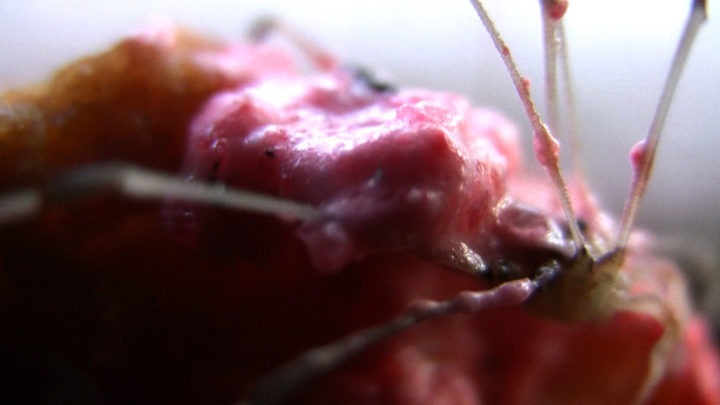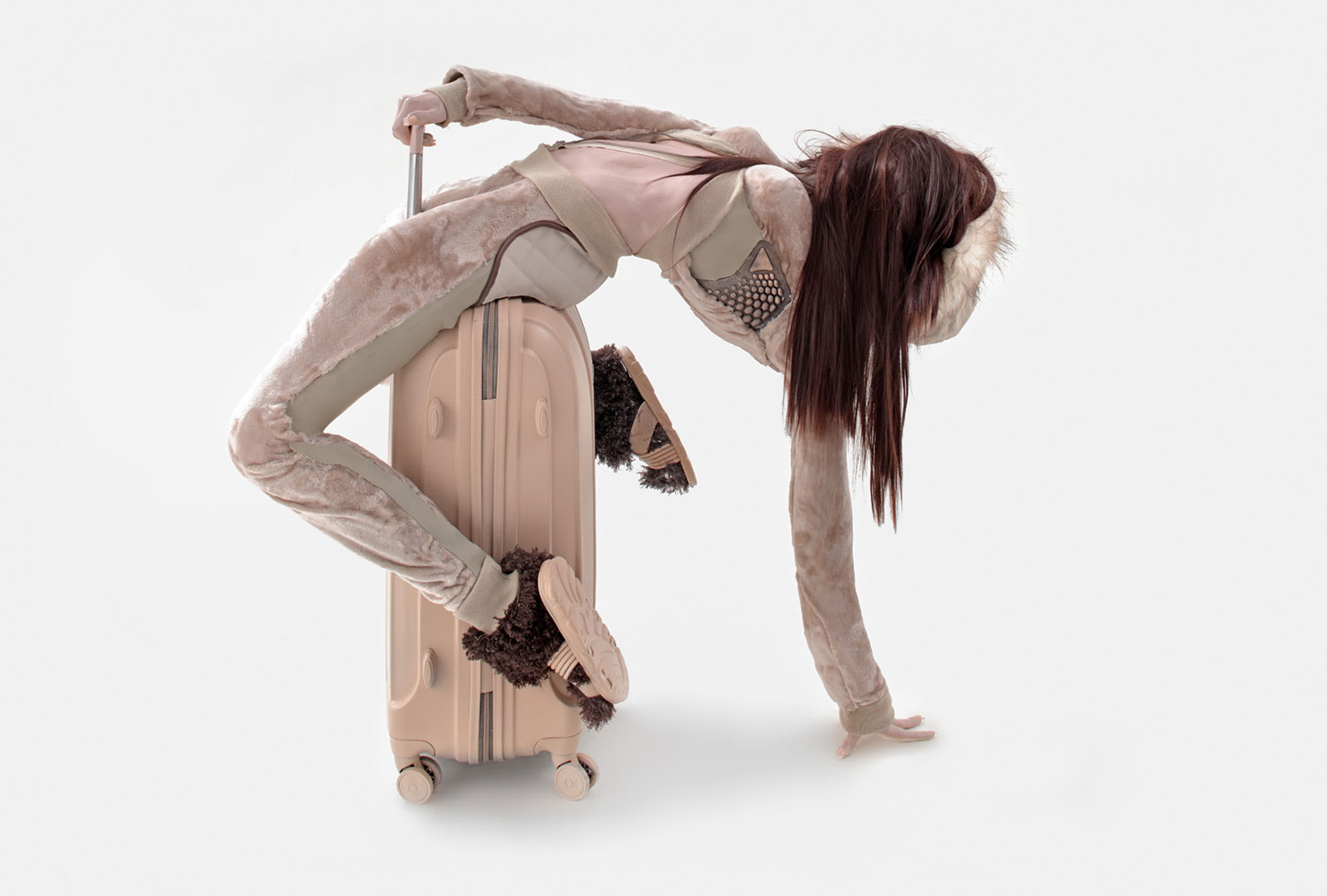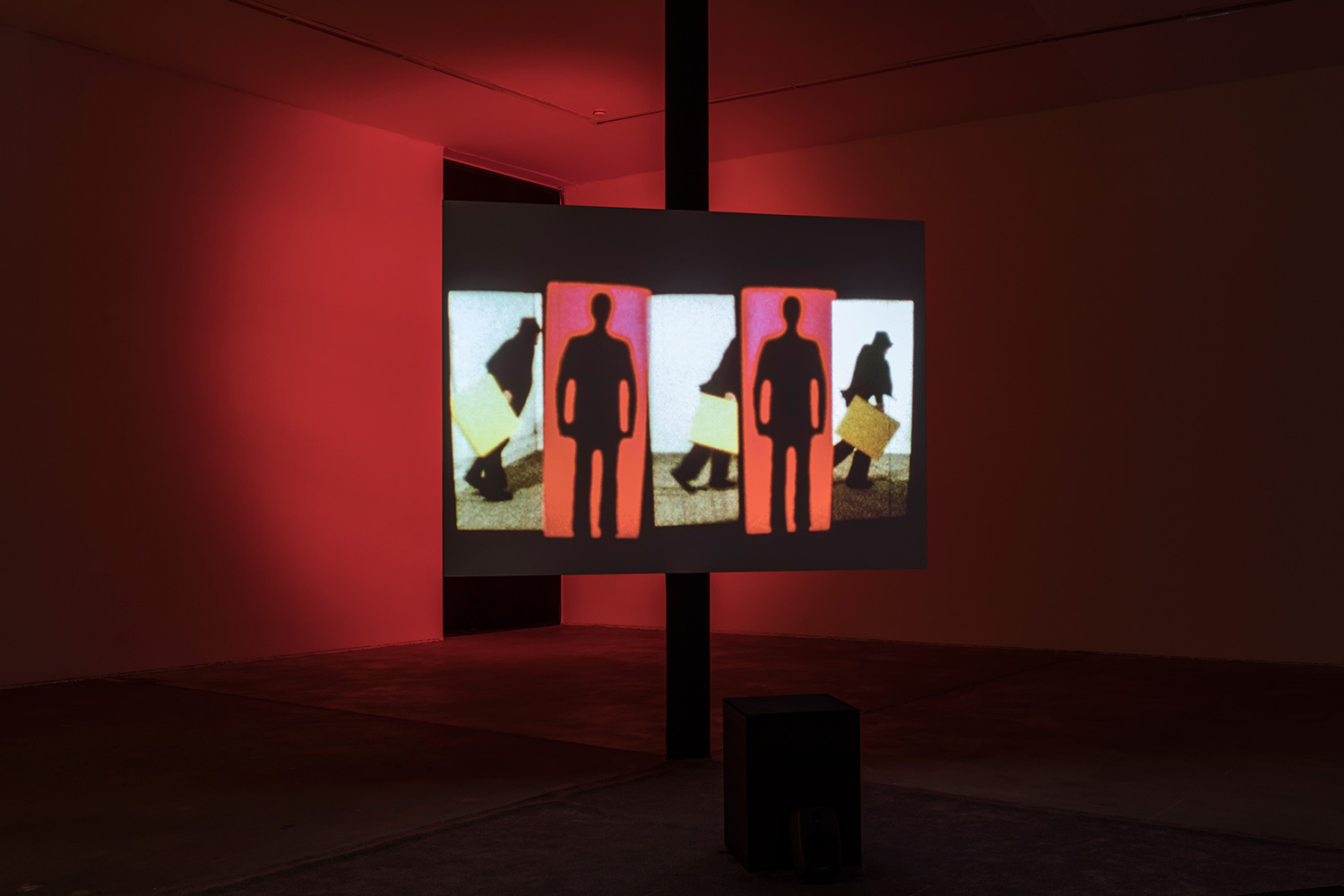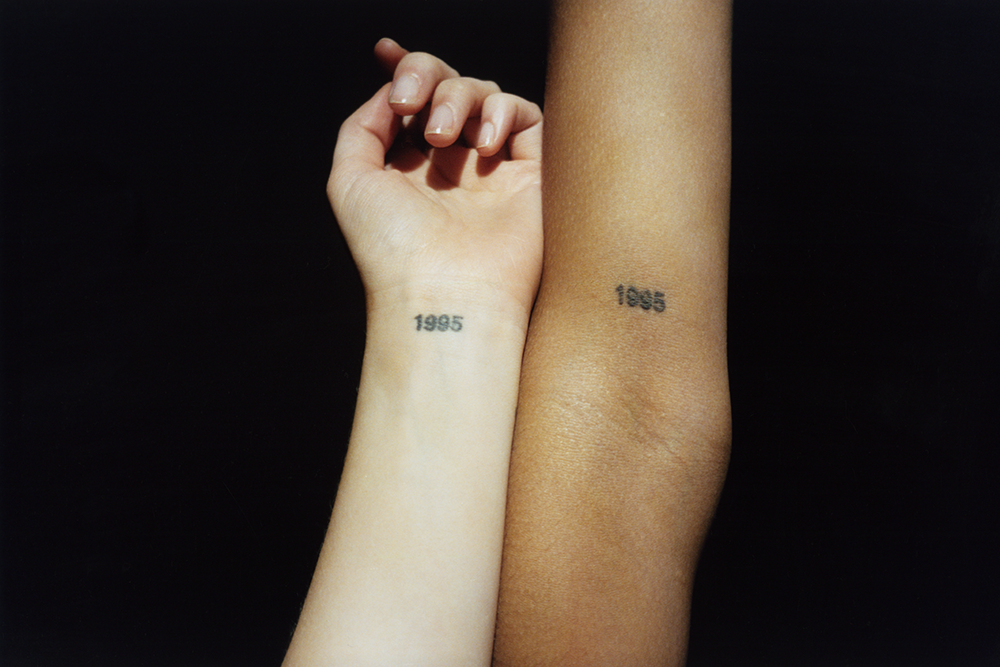
What does my body know of photography?
— Roland Barthes
The opening moment of Quentin, a 2010 video by Josh Tonsfeldt (b. 1979, US; lives in New York), is a ground-angle bucolic scene, replete with leaves, moss, and a tree trunk, swiftly taken over by a close-up of fry bread smothered in pink pudding and dirt. “Get back over there, buddy,” a child’s off-camera voice whispers to the now-inedible treat as he shoves it so close to the camera that it nearly monopolizes the frame. “What about this?” he offers, as the legs of a squirming spider enter from the right, dancing frantically as they are repeatedly mired in and freed from the saccharine mess. “Right there,” he says with studied satisfaction as he continues to manhandle the arachnid’s body, fingering it into the dessert, drowning it in the fleshy goo. Tonsfeldt’s camera remains fixed throughout, its distracted autofocus constantly gliding from one point to another as it struggles to manage its lush surroundings.
Exhausted, the victim remains motionless for a moment, its sunlit exoskeleton rendered a translucent, speckled tan against the sticky backdrop. Nearby conversation is heard. The squeak of a toy. Clicks of a lighter. It seems like a family outing. “Do you think he’s gonna survive?” an older asks the younger. “Yeah… probably so,” says the boy, weighing this against prior experience. “It’s only pudding.” The spider eventually frees itself and scuttles out of view. A twig descends from above, audibly penetrating the dessert. A shadow of the spider — apparently still within the boy’s clutches — appears in raking light on the bark’s tactile ridges. This intimate, even claustrophobic scene continues in this vein for several moments before the camera is moved back, revealing the pastoral setting in full view, and then abruptly cuts off. Filmed in a single five-and-a-half-minute take at a summertime family gathering, Tonsfeldt’s video is at once visceral and seductive.
The themes that comprise Quentin — material truth, capture of quotidian subjects, embrace of the capabilities and limitations of digital apparatuses, engagement with the body’s increasingly inextricable relationship to cameras and screens — are characteristic of Tonsfeldt’s approach to artmaking. With these actions and circumstances in mind, he investigates the manners in which reality can be captured, processed, and consumed. He destabilizes and restructures images through various digital and physical processes, laying bare or thoroughly reworking elements of their construction, or else dismantling and repurposing their means of display. Traversing material strata, Tonsfeldt’s work can be seen as a continual investigation into — and a processing of — the porous border between the photographic and the corporeal.
Tonsfeldt does not primarily identify as a photographer, and yet the sequences and procedural operations inherent to photographic and cinematic activity — interplay between operator and apparatus, image capture, manipulation of the channels through which images travel, printing — inform virtually all aspects of the artist’s output. Importantly, Tonsfeldt, like Vilém Flusser before him, holds that the apparatus of image capture is an extension of the body’s senses, a prosthesis that facilitates an augmented and intensified engagement with the world. The creation of works of art is not, Tonsfeldt claims, of primary importance, but is rather the inevitable product of his engagement with the photographic, which we might define, following Howard Singerman, as “neither a medium nor the instance of a medium. Rather, it is something like the technical condition of photography, its reproducibility, its circulation, and its dumbly indexical, contingent ties to the world.”1

Tonsfeldt’s artworks stem from an intense personal relationship to the devices and materials he employs; as he gets to know them intimately they become not only instruments of capture but also veritable extensions of his own body. His works are imbued with a sensorial aura, a palpable residue of emotional connection between object and author — a material soul. This intimacy with apparatuses and materials can be glimpsed not only when the machines and processes are running smoothly, but in their potential for disruption and failure as well.
These interests were foregrounded in the artist’s 2013 exhibition at New York’s Simon Preston Gallery, a self-illuminated, environmental installation in which the artist presented several wall-based works, many of which were printed on the reverse side of photo paper, a material that, depending on the ink in question, accepts or rejects the printer’s efforts. In Untitled (2013), for instance, the artist printed an image onto the back of a large piece of photo paper and while the ink was still wet he wiped it away, leaving a cerulean palimpsest. On top he printed an image of Bart Simpson broken up into three out-of-order segments, staggering the smaller image over the larger, effaced one. Here Tonsfeldt is frustrating image legibility through the index of the work’s very own creation. Elsewhere in the same exhibition, the artist pushed these indexical notions further by making rectangular plaster casts of the floor and installing them vertically side-by-side in the middle of the gallery, thereby constructing a wholly new, mimetic architecture within the space. These “walls,” like photographic negatives, bore indexical relations to their source; every crevice and crack made a physical protuberance.

As regards the negative, Tonsfeldt’s output is entirely free of it, as he has only ever employed digital cameras. A great deal of twentieth-century discourse on photography emphasizes the primacy of the negative as the gatekeeper of photographic inversion, reproduction, and dissemination. However, as George Baker has observed, “With the shift from analog to digital media in recent decades, few have mourned the fact that this transition has included the loss of the negative from most of the dominant forms of current photographic processes. Whether considered as the matrix of the voyage of the image from camera to print or as the former primary modality of image storage, the negative once embodied the central operations of both photography and film, and yet it has hardly been noted that in recent years the negative has simply been swept away.”2
While digital cameras are of course instruments of indexical faculty, they have nonetheless shifted emphasis from a relationship between author and negative to a fusion of operator and apparatus and the consequent “lens-based aesthetics” of the post-darkroom photographic era. Tonsfeldt’s images go entirely through digitally coded channels; from the point of initial capture up until the point of execution, they exist completely outside the realm of the physical, residing only in the hermetic vacuum of digital circuitry.
If anyone jettisoned the discourse of the negative in favor of a scrutiny of the seamless fusion of user and device it was Flusser, who in 1983 presaged photographic ubiquity as “a new kind of function in which human beings are neither the constant nor the variable but in which human beings and apparatus merge into a unity.”3 Flusser emphasized the non-impartiality of the apparatus, explaining that what it depicts is not “real,” but rather a transformed index of reality that comes about as a result of the apparatus’s ability to record objects, regardless of any presence of the negative.

Seen through this lens, plaster is an instrument capable of photographic mimesis in its own right. Tonsfeldt’s use of the material is not only a means of inverting the contours of three-dimensional objects, it is also a receptacle of two-dimensional image transfer. The artist fused these capacities in “Adrenaline,” a 2015 show, wherein high-resolution photographs were printed onto single and multipart hydrocal casts. Adrenaline Tattoo, for example, is a cast of Tonsfeldt’s studio worktable upon which he superimposed two parts of a single, peeled-apart LCD screen removed from a flat-screen television. Printed onto the surface of the hydrocal cast is an image depicting a man getting a rectangular tattoo on his chest while his arms are otherwise occupied — his left an ad hoc pillow, his right raised and holding an iPhone, presumably to record the process. Surreptitiously shot from the exterior of the tattoo shop, a glass barrier had separated the artist from his subject.
A physical connection between the printed image and how the material accepts it (crisp resolution where the surface is flat, murkiness in its lacunae) makes it so the eye “feels” the image. Meanwhile, the screen appears as a kind of skin, a porous boundary through which sensorial information is synaptically transferred then transmitted. As the image rides over the cast surface there is a dovetailing of affect: the work’s rectangular shape, the casts of the screens, the man’s tattoo, his iPhone, and the glass “screen” separating subject and witness all echo a screen’s form and function: seen together they act as a bridging of the corporeal and the digital.
What could be more emblematic of the dermal exchange between machine and body than a touchscreen? As Laura Glitsos has commented, “Touchscreens imply the relationship between skin on skin — the skin of our body (in particular the hands) against the skin of the screen. It follows that mobile touchscreen devices suggest a degree of sensuality — in the coming together of bodies, fluids, and other organic materials which ‘stick’ to the touchscreen.”4 At what point does this fluidity become transmutable into other realms? As technology progresses and the lines between life and work, screen time and lived time, the real and the virtual, become blurred — and the self increasingly layered and fluid — the body’s engagement with the screen is omnipresent.
Just as the viewfinder marks the commencement of photographic reality, the framed or screened image is the culmination of its sequence. Indeed, life, work, and leisure are all now experienced through a succession of screens. With this hegemony in mind, Tonsfeldt recently embarked upon two interrelated bodies of work that explore the physiological nature of the screen through absence and presence.

The first is a series of disrupted and augmented flat screen televisions. The LCD displays found within, similar to the epidermal and dermal strata of skin, are layers of extremely thin films that can be peeled apart and removed. Without them, the television is just a grid of lights in a plastic vessel. If moving images are to be viewed as intended, their information must first go through these diffusion and prism films, then the LCD screen itself. Surprisingly, when these films are removed, the LCD display still functions, albeit with different results: “white” information is invisible, and the viewer sees nothing but the lighting grid, but “black” and color images can still be read. In Untitled (2016), for example, Tonsfeldt excised the interior films and glued several items to its grid, including dried vegetation and pieces of clothing. Over this backdrop a video of a pulsating flashlight appears within a floating black animation. The viewer’s attention is thrust from the video to the very mechanisms that enable its legibility, to the familiarity of the objects and back again. The work’s effect, almost respiratory, is utterly hypnotic.
The second is a series of cast hydrocal works that are a seamless fusion of frame and receptacle. Their internal compositions are an admixture of fragmented objects and imagery problematized by the application of the extracted television prism films. The films have a polarized lens effect, obscuring what lies behind them when viewing the work frontally, coming into clearer focus when the viewer moves to either side. Despite this connection between viewer and object, the prism film barrier renders the underlying imagery unattainable, perpetually mediating the viewer’s direct engagement with it, culminating in an entanglement of desire and frustration.
In the press release for “Adrenaline” Tonsfeldt states, “Familiarity becomes something slippery in the timespan of making a picture. The tenderness felt toward a loved one can emerge like a program between you and the camera, a machine-body behavior ready to play itself out in situations untethered from its source.” Indeed, Tonsfeldt’s work has the familiar at its core: forever processing it, abstracting it, pulling it apart, and pushing it into other registers, while never letting it go.






